A Day in the Life of a pH Analyst on board the R/V Thompson.
Abby Tinari is a pH Analyst on GO-SHIP I08S.
My name is Abby Tinari, I am an engineer (undergrad), marine ecologist (masters), and chemical oceanographer (experience). I08S is my 5th long cruise and the 5th GO-SHIP parameter I’ve analyzed. On past cruises I sampled dissolved organic carbon (DOC) / Total dissolved nitrogen (TDN) and 14C (which were analyzed on shore), and sampled and analyzed Chlorofluorocarbons (CFCs), total alkalinity (TA) and pH. This cruise, although like many of my other cruises in many ways, is different because of 1) the long transit and 2) the multitude of weather days.
I am one of two pH operators and one of many scientists on I08S. Most of the scientist’s shifts are either day shift (noon – midnight) or night shift (midnight – noon), which means that most of us have a counterpart so we can collect and run samples 24/7.
I am on day shift so I will typically wake up around 9:30 am or 10:30 am, (sounds like a teenager’s dream right?), depending on where we are in the sampling cycle. I’ll head upstairs to the main lab where I will say hi to the night-shifters. I will also check in with my counterpart to see how the machine is running or if there were any issues from the night before. My first meal starts at 11:30 am, so I’ll head up another floor to the mess where I eat lunch—well, really breakfast, which can be interesting way to start my eating journey for the day. Tacos or burgers for breakfast anyone? Lunch on the ship is from 11:30 am to 12:15 pm so people on both day and night shift are able to eat, but this also means that I need to go relieve my counterpart before 12 pm so she has enough time to eat. Here’s where my typical day changes based on the rosette status.
Running Samples
If the rosette is in the water or we are transiting to the next station I get to start my shift analyzing samples. If my counterpart is in the middle of running a station I will continue with that run. To prepare the samples, I uncrimp (or uncap) one sample at a time and insert a small tube into the bottle. The Kloehn syringe pump (our dispensing system) will draw up a portion of the sample through the tube and transfer it into the spectrophotometer cell as a blank. While the Kloehn is pushing the sample into the cell, I check the cell for bubbles that may affect the spectrophotometer reading. Once the Kloehn has transferred the blank to the cell it will again draw up another portion of the sample from the bottle and inject a dye into the sample.
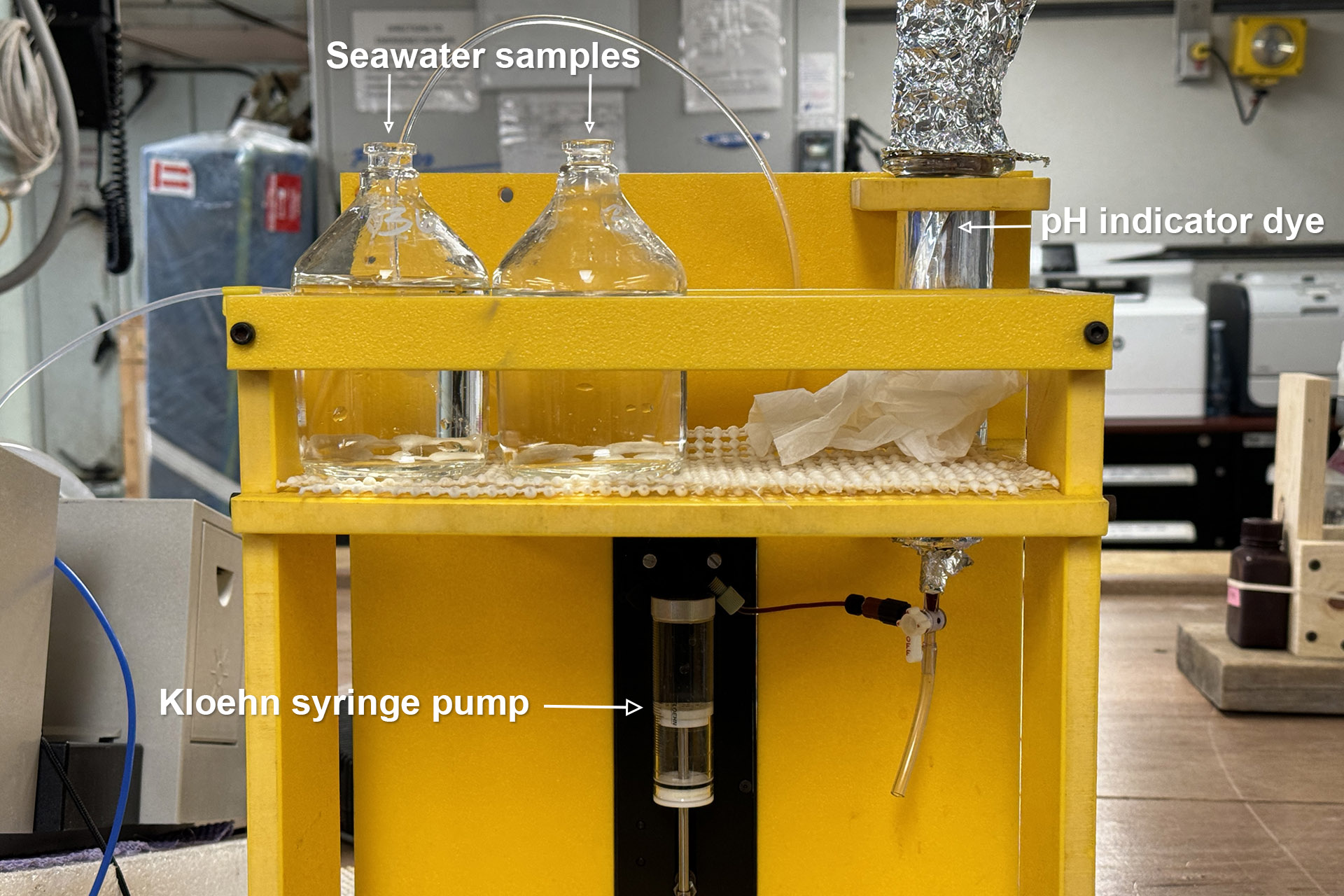
Seawater pH is measured onboard using spectrophotometry.
The spectrophotometer takes about 3 minutes to analyze the blank and another 3 minutes to analyze the sample with dye. During these 6 minutes I will write down the information about the sample that is running. We record the station, cast, and sample. We also take duplicates and sometimes inject varying amount of dye into the sample, so this information gets recorded in the computer as well as in a lab notebook as well. After the machine reads the blank (after 3 minutes) I can uncap and load the next sample, so I typically do this so samples are running more efficiently. Analyzing one station can take between 2 and 4 hours depending on the number of samples we collected. I also have to make sure I run a CRM (certified reference material) each day towards the beginning of my shift. This CRM allows us to check how the spectrophotometer is running. We know the exact pH of the CRM so our values should be extremely close (± 0.005). This happens most of the time, which is convenient.
Once that is complete I knit or cross stitch depending on my project at the time, or I’ll read. If I’m motivated enough, I’ll work on other projects like my acoustic work (I listen for boat noises and grouper sounds from underwater microphones) or work on preparing papers for publication. If we are getting close to sampling another station, I will work to record the pH and alkalinity numbers on the sample log sheet and I will prepare bottles so we are ready to sample when the rosette comes out of the water.
Collecting Water for Sampling
If the rosette is on deck and we are sampling, I will get my boots and pants on and head out to the sampling bay and pick up sampling where my counterpart left off. I communicate with the “sample cop” to make sure I am collecting from the correct Niskin bottle, and all the samplers are sampling in the correct order. We have a specific sampling order due to samples that are gas sensitive; pH is one of those samples. I am fourth in the line-up—CFCs/Tracers are first, Oxygen is second and DIC (Dissolved inorganic carbon) is third. Out in the sampling bay we have the chance to talk with and see some of our fellow scientists who work in different labs. We will put music on and dance and sing. On past cruises this is also a time for people to go outside as the sampling bay doors will be open. On this cruise however, it’s been too cold (for the rosette sensors and for some of the scientists, myself included) to have the doors open so we keep them closed, but I cannot wait to get farther north so we can have the doors open again.
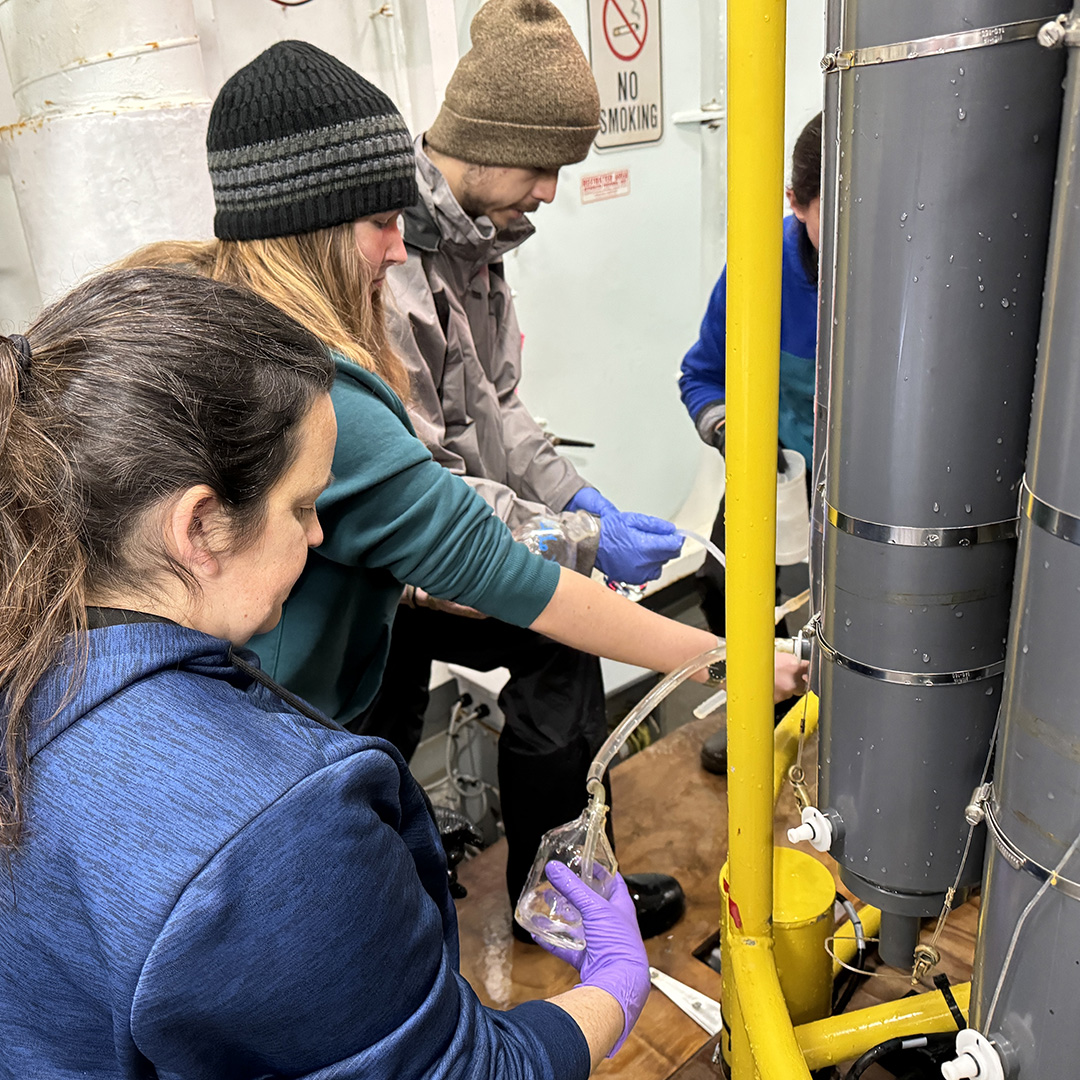
pH is fourth in line for sampling, so Abby collects from each bottle when it’s her turn.
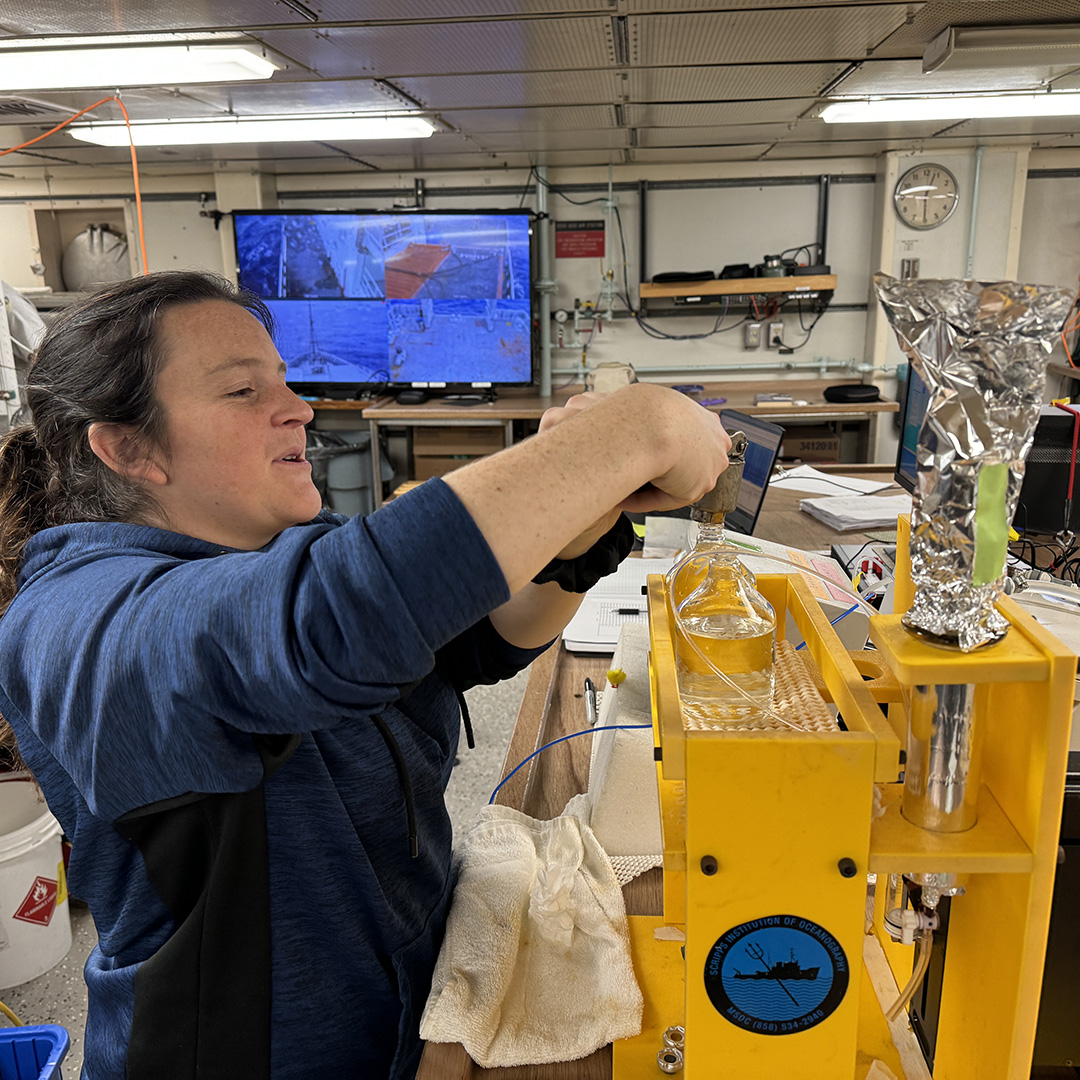
Abby uncrimps a sample bottle for processing in the spectrophotometer.
Once we get into sampling more consistently, I will alternate between analyzing samples, sampling, eating, and sleeping. The days look slightly different in terms of the timing of sampling vs analyzing samples, but overall it’s the same motions. Dinner is served from 5 – 6 pm, which is halfway through the day shift, and we hope the rosette doesn’t come up during that time. If it does, we will have to wait to eat until after we sample, but there is usually someone who can grab a plate for everyone who’s busy sampling. Luckily, on this cruise we haven’t had to sample during dinner yet (Yay!).
![Abby Chart A day in the life of a pH analyst]</p>
<p>](https://www.go-bgc.org/wp-content/uploads/2024/03/abby-chart-scaled.jpg)
A day in the life of a pH analyst.
Down Time
Like I mentioned earlier, this cruise has been different than my previous cruises. We had 12 days of transit at the beginning of the cruise (it was originally 9 days but was extended due to weather) so many of the non-seasick scientists spent these transit days in the library playing card games, reading, completing puzzles, collaborating on the New York Times crossword and just generally trying to keep the boredom at bay. These days were very much like Bill Murray’s Groundhog Day: there were multiple days in a row where the chief scientists told us just 8 more days to station. And now, as we sit at 56.4835°S, 83.7699°E, we are starting science again, after our second 16+ hour weather delay, this time hoping the weather will hold for more than a day. Boredom is rampant, so games are being made up, manifestos are being written just to pass the time, but spirits on both shifts are high.
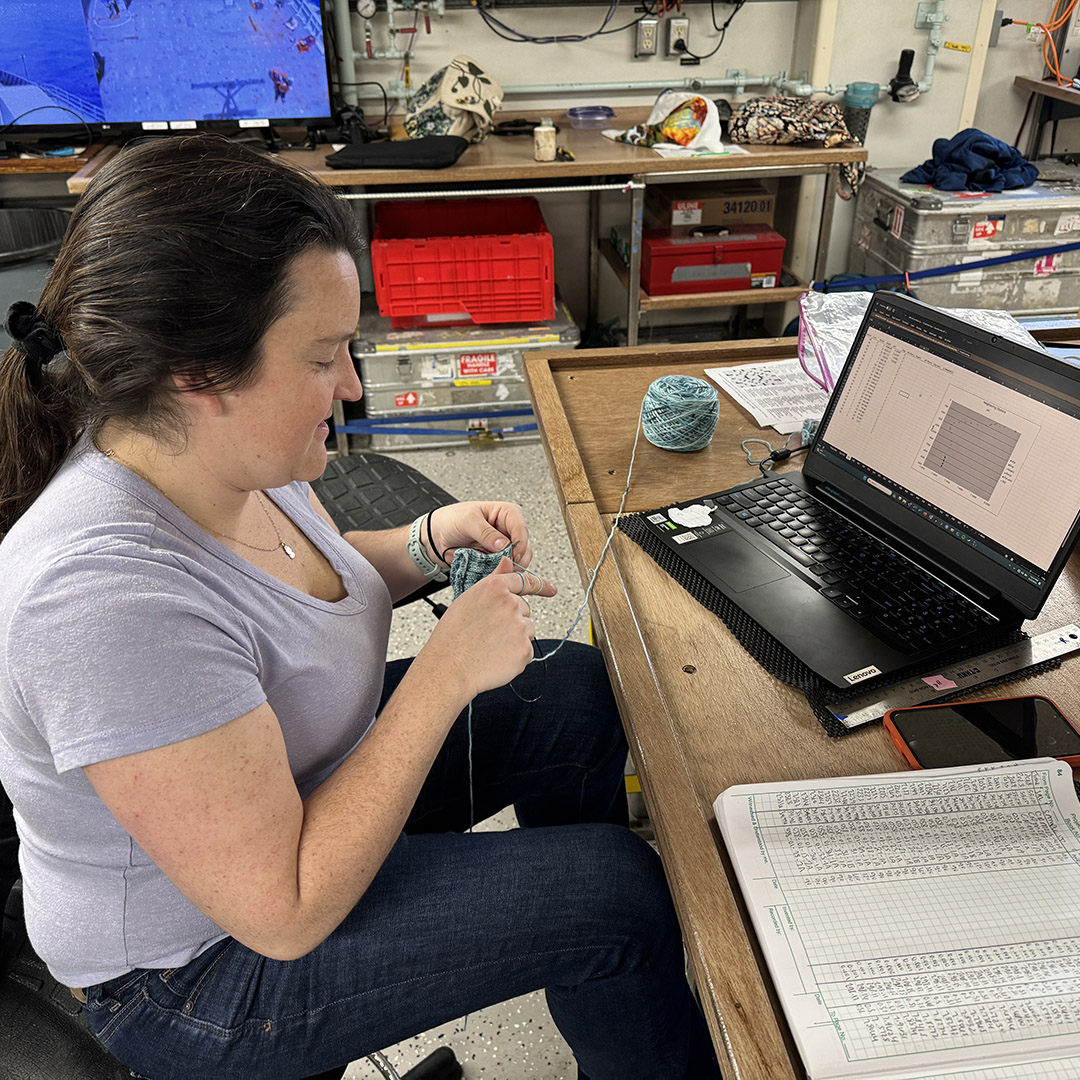
Abby working on a knitting project as her samples process.
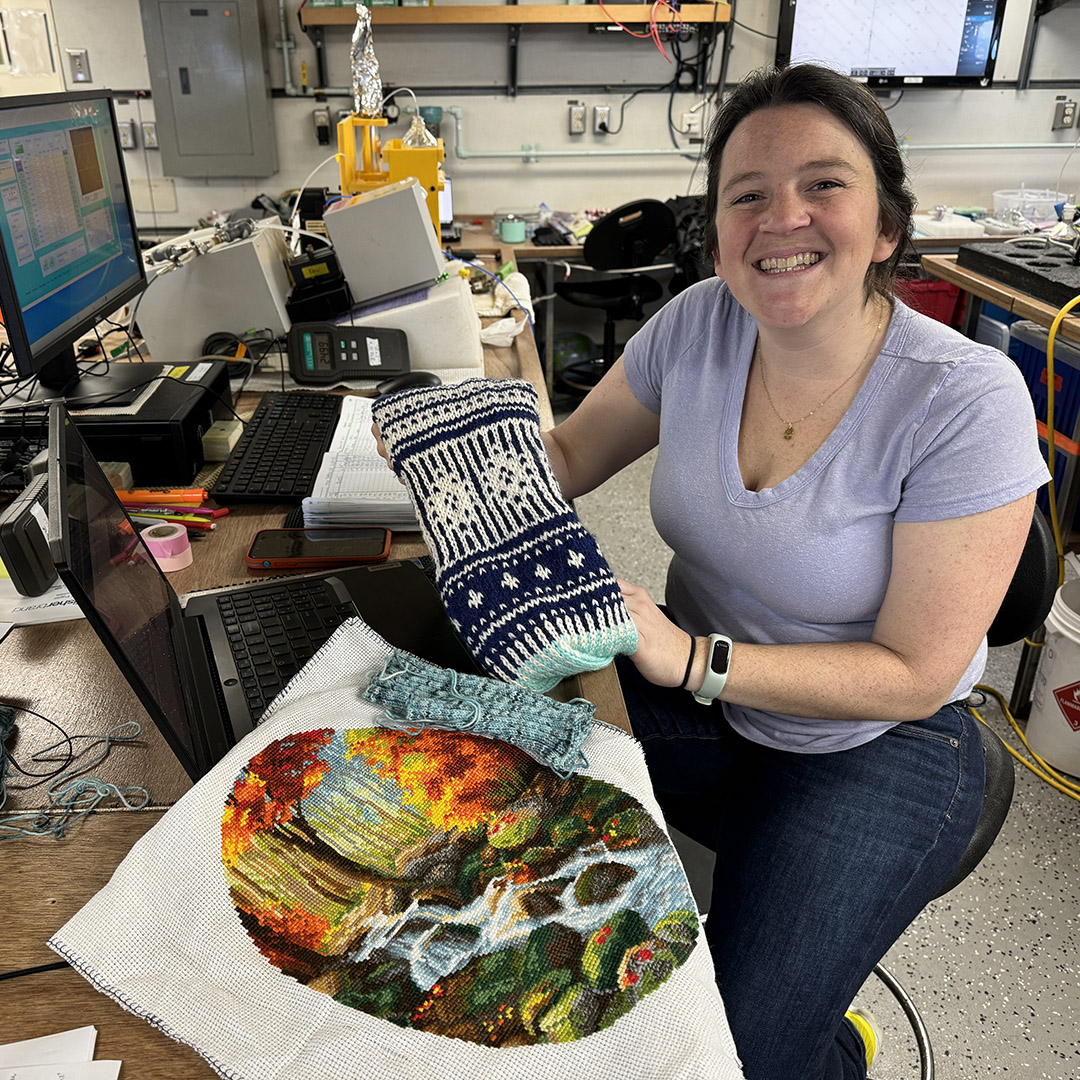
Abby shows off some projects she has finished during I08S.
